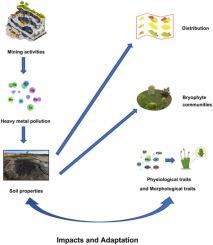草履本植物通过改变其功能特性来适应露天煤矿环境,以应对重金属引起的土壤环境变化
IF 12.2
1区 环境科学与生态学
Q1 ENGINEERING, ENVIRONMENTAL
引用次数: 0
摘要
植物对重金属污染有独特的适应能力。然而,红叶植物的适应策略尚不清楚。为了更好地了解红叶植物对不同重金属的响应以及不同物种对重金属污染的适应机制,我们对内蒙古大型露天煤矿土壤理化性质、重金属元素分布、生态风险评估以及红叶植物群落结构、功能特征进行了研究。结果表明1)目前三个露天矿区的土壤并不存在重金属污染的生态风险,但在研究区的大部分地区发现了高浓度的锌、汞;2)单一重金属的存在驱动着特定类群的红叶植物的分布。除汞、铅和锌外,其他重金属都会对红叶植物群落结构产生重大影响;3)除铅和汞外,其他重金属都会对红叶植物的功能特性产生影响;4)不同的红叶植物类群会通过改变其功能特性(叶片、叶片细胞或植株大小)来适应重金属污染造成的土壤环境变化。本文章由计算机程序翻译,如有差异,请以英文原文为准。

Bryophytes adapt to open-pit coal mine environments by changing their functional traits in response to heavy metal-induced soil environmental changes
Plants have unique adaptability to heavy metal pollution. However, the adaptation strategies of bryophytes are still unclear. In order to better understand the response of bryophytes to different heavy metal and the adaptation mechanisms of different species to heavy metal pollution, we studied soil physicochemical properties, distribution of heavy metal elements, ecological risk assessment and the community structure, functional characteristics of bryophytes in large open-pit coal mines in Inner Mongolia. The results indicate that: (1) The soil in three open-pit mining areas currently does not pose an ecological risk from the heavy metal pollution, but high concentrations of Zn and Hg are found in most parts of the study area; (2) The presence of a single heavy metal drives the distribution of specific taxa of bryophytes. Apart from Hg, Pb, and Zn, all the other heavy metals significantly impact the community structure of bryophytes; (3) With the exception of Pb and Hg, all the other heavy metals have an influence on the functional traits of bryophytes; 4) Different taxa of bryophytes will adapt to changes in soil environments caused by heavy metal pollution by altering their functional traits (blades, leaf cells, or plant size).
求助全文
通过发布文献求助,成功后即可免费获取论文全文。
去求助
来源期刊

Journal of Hazardous Materials
工程技术-工程:环境
CiteScore
25.40
自引率
5.90%
发文量
3059
审稿时长
58 days
期刊介绍:
The Journal of Hazardous Materials serves as a global platform for promoting cutting-edge research in the field of Environmental Science and Engineering. Our publication features a wide range of articles, including full-length research papers, review articles, and perspectives, with the aim of enhancing our understanding of the dangers and risks associated with various materials concerning public health and the environment. It is important to note that the term "environmental contaminants" refers specifically to substances that pose hazardous effects through contamination, while excluding those that do not have such impacts on the environment or human health. Moreover, we emphasize the distinction between wastes and hazardous materials in order to provide further clarity on the scope of the journal. We have a keen interest in exploring specific compounds and microbial agents that have adverse effects on the environment.
 求助内容:
求助内容: 应助结果提醒方式:
应助结果提醒方式:


